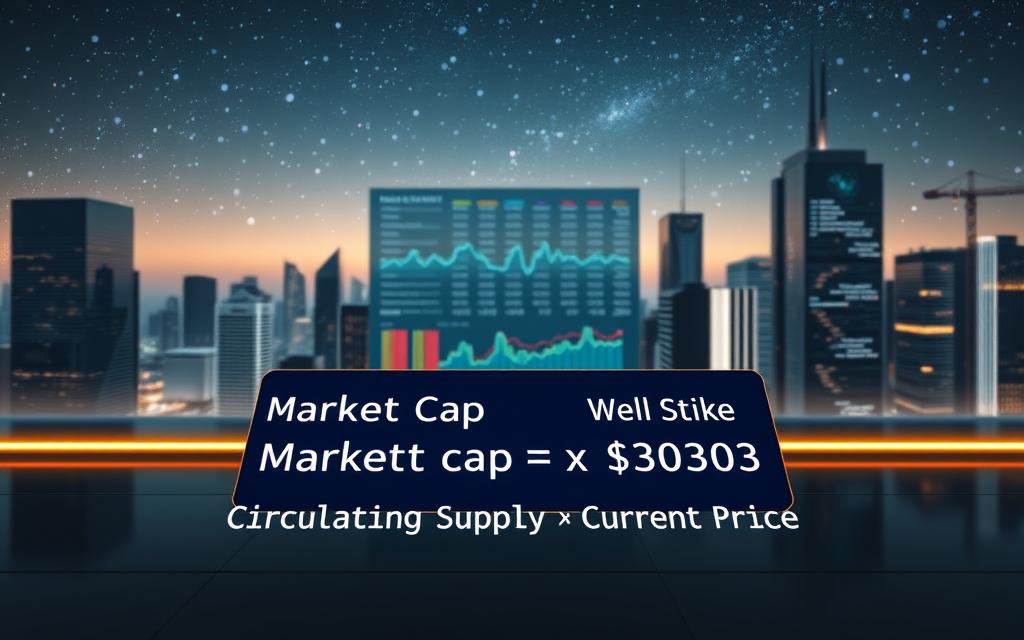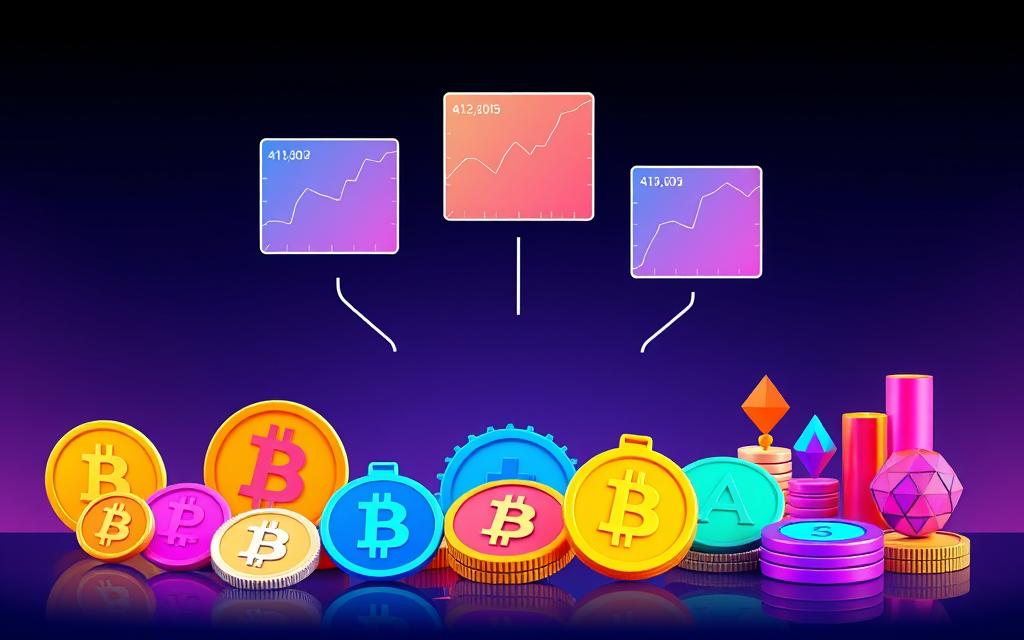Table of Contents
Market capitalization plays a crucial role in evaluating digital assets. It represents the total value of all circulating coins for a specific cryptocurrency. This metric helps investors gauge a project’s size and stability within the competitive blockchain space.
Similar to traditional stock markets, market capitalization ranks assets by their overall worth. Popular platforms like CoinMarketCap track these valuations, offering real-time comparisons. Larger figures typically indicate more established projects, while smaller ones may suggest higher growth potential.
Investors often use this data when making decisions about portfolio allocation. However, it’s just one factor among many to consider. The metric reflects popularity and adoption over time, but doesn’t guarantee future performance.
This guide will explore how market capitalization works, why it matters, and how to interpret it effectively. You’ll learn to compare different cryptocurrencies and understand what these numbers truly represent.
What Is Market Cap in Crypto?
A project’s financial health in blockchain ecosystems hinges on its total valuation. This figure, derived by multiplying the current price by the circulating supply, reflects real-time economic influence. Unlike traditional metrics, it ignores locked or unminted tokens.
Platforms like CoinMarketCap aggregate exchange data to compute accurate valuations. These calculations use volume-weighted averages, minimizing price manipulation effects. Daily fluctuations directly alter a project’s ranking.
Here’s why supply types matter:
| Supply Type | Definition | Used in Valuation? |
|---|---|---|
| Circulating | Coins actively traded | Yes |
| Total | Existing coins (including locked) | No |
| Max | Maximum possible coins | No |
Consider stocks: Apple’s valuation isn’t based on potential shares but actual ones. Similarly, 70% of traders compare blockchain projects using this metric rather than individual coin prices. Larger valuations often signal stability, while smaller ones hint at growth potential.
Projects fall into three tiers—large, mid, and small—based on this number. This classification helps investors balance risk and reward across portfolios.
How Is Market Cap Calculated in Cryptocurrency?
Understanding valuation mechanics helps investors analyze digital assets effectively. The formula relies on two critical components: the current price per coin and the circulating supply. Multiplying these figures reveals a project’s total worth.

Market Cap Formula: Price × Circulating Supply
For Bitcoin, a $40,000 price with 19.5 million coins in circulation equals a $780 billion valuation. This straightforward math applies universally. Smaller projects might show lower prices but higher supplies, skewing perceptions.
Platforms like CoinMarketCap aggregate exchange data to compute accurate figures. They use volume-weighted averages to minimize manipulation risks. Daily price swings directly impact rankings.
Why Circulating Supply Matters (Not Total Supply)
Only tradable coins affect valuation. Projects with large locked reserves—like XRP—can appear artificially inflated if total supply is used. Ethereum’s shifting supply mechanics further highlight why circulating numbers are the standard.
Key differences:
- Circulating: Actively traded coins (used in calculations)
- Total: Includes locked/unreleased tokens (misleading for valuation)
- Max: Theoretical maximum supply (irrelevant for current worth)
Example Calculation: Bitcoin vs. Small-Cap Altcoins
Bitcoin’s scarcity drives its high per-coin value. Conversely, altcoins with billions in circulation may trade for pennies but still achieve large valuations. XRP’s $3.84 peak versus Bitcoin’s $20,000 illustrates how supply impacts price perception.
Fully diluted valuations—assuming all tokens are released—often mislead investors. Always verify circulating numbers before comparing projects.
Why Market Cap Matters for Crypto Investors
Investors rely on valuation metrics to navigate the volatile crypto landscape. This figure reveals a project’s maturity, liquidity, and stability, helping traders make informed investment decisions. Unlike coin price alone, it accounts for circulating supply, offering a clearer picture of actual worth.
Assessing Stability and Risk
Large-cap assets (>$10B) typically exhibit lower volatility, attracting conservative investors. Mid-cap projects ($1B–$10B) balance risk and reward, while small-caps (growth potential but with increased unpredictability.
| Category | Volatility | Investor Profile |
|---|---|---|
| Large-cap | Low | Institutions, long-term holders |
| Mid-cap | Moderate | Balanced portfolios |
| Small-cap | High | Speculative traders |
Comparing Cryptocurrencies Objectively
Valuation levels the playing field. A $0.10 coin with 50B supply outweighs a $5 coin with 10M supply. This prevents price-based misconceptions, emphasizing total economic impact over individual unit cost.
Market Cap vs. Coin Price: Why the Difference Matters
Price reflects scarcity; valuation reflects adoption. Bitcoin’s high price stems from limited supply, while meme coins with trillions in circulation trade cheaply. Always cross-check trading volume—high valuation with low volume signals liquidity risks.
For balanced exposure, consider diversifying your crypto stash across tiers. This mitigates sector-specific shocks while capturing varied opportunities.
Cryptocurrency Categories by Market Cap
Digital assets are commonly classified by their total valuation into distinct tiers. These groupings help investors assess risk profiles and growth potential across different project sizes. Most platforms use three primary classifications.

Large-Cap Cryptocurrencies (Over $10B)
Projects like Bitcoin ($1.3T) and Ethereum ($424.8B) dominate this tier. Their massive valuations signal established networks with lower volatility. Blue-chip assets in this category often serve as portfolio anchors.
Binance Coin ($89.9B) demonstrates how exchange tokens can achieve large-cap status. These assets typically weather market downturns better than smaller projects. However, their upside potential may be more limited.
Mid-Cap Cryptocurrencies ($1B-$10B)
Solana ($70.8B) and Chainlink lead this emerging segment. Many focus on niche sectors like DeFi or NFTs, offering balanced growth potential. Their valuations sit between stability and opportunity.
These token projects often show higher adaptability than large-caps. Investors should monitor development activity closely, as mid-tier rankings fluctuate frequently.
Small-Cap Cryptocurrencies (Under $1B)
This category includes newer projects and meme coins like Dogecoin ($24.39B). While offering explosive upside, they carry substantial risk. Pump-and-dump schemes frequently target these assets.
Historical data shows small-caps outperform during bull markets but suffer most in downturns. For exposure, consider tracking emerging crypto companies with solid fundamentals.
Understanding these categories helps build diversified portfolios. Each tier serves different strategic purposes in blockchain investing.
Limitations of Market Cap as a Crypto Metric
While valuation metrics offer insights, they aren’t flawless indicators. Many investors over-rely on this number without understanding its blind spots. Three critical limitations can distort perceptions of blockchain projects.

Market Manipulation Risks
Low-volume projects often fake their numbers through wash trading. Exchanges with thin liquidity can artificially inflate prices, creating misleading valuations. One study found 70% of small-cap assets showed signs of this manipulation.
Consider this red flag checklist:
- Disproportionate valuation to development activity
- Exchange listings limited to obscure platforms
- Spikes in trading volume without news triggers
Fully Diluted Market Cap Misconceptions
Some projects count locked tokens in their reported supply. XRP’s 1B total versus circulating coins demonstrates how this inflates perceived worth. Future token unlocks can crash prices when new supply hits markets.
Key differences:
| Valuation Type | Accuracy | Risk Factor |
|---|---|---|
| Circulating | High | Low |
| Fully Diluted | Low | High |
Ignoring Trading Volume and Liquidity
A high valuation means little without active trading. Projects with thin order books may show stable prices until large sell orders appear. Always cross-check 24-hour volume against valuation.
Practical verification steps:
- Compare volume across multiple exchanges
- Check order book depth for large gaps
- Monitor unlock schedules for vested tokens
For balanced analysis, combine valuation with on-chain metrics like active addresses and network growth. This multi-angle approach reveals truer project health.
Conclusion
Smart investors use multiple tools to assess digital asset potential. Market cap remains a foundational metric, revealing a project’s scale and adoption. Yet, it’s just one piece of the puzzle.
Combine it with trading volume, development activity, and tokenomics for a full picture. Avoid chasing small-cap projects without thorough research—higher rewards often come with steep risk.
Platforms like CoinMarketCap simplify real-time tracking. Use these tools to balance your investment portfolio across large, mid, and small-cap assets.
Remember, the crypto space is volatile. Regular monitoring and diversified strategies are key to long-term success.
FAQ
How is market capitalization calculated for cryptocurrencies?
A: Market cap is determined by multiplying the current price of a coin by its circulating supply. This excludes locked or reserved tokens, focusing only on those actively traded.
Why does circulating supply matter more than total supply?
A: Circulating supply reflects coins available for trading, directly impacting price and liquidity. Total supply includes inactive tokens, which can distort real-world valuation.
What separates large-cap from small-cap cryptocurrencies?
A: Large-cap assets (over B) like Bitcoin offer stability, while small-cap coins (under
FAQ
How is market capitalization calculated for cryptocurrencies?
A: Market cap is determined by multiplying the current price of a coin by its circulating supply. This excludes locked or reserved tokens, focusing only on those actively traded.
Why does circulating supply matter more than total supply?
A: Circulating supply reflects coins available for trading, directly impacting price and liquidity. Total supply includes inactive tokens, which can distort real-world valuation.
What separates large-cap from small-cap cryptocurrencies?
A: Large-cap assets (over $10B) like Bitcoin offer stability, while small-cap coins (under $1B) carry higher risk but greater growth potential.
Can market cap alone determine a cryptocurrency’s value?
No. While useful for comparisons, market cap ignores factors like trading volume, liquidity, and project fundamentals. Always analyze multiple metrics.
Why do investors use market cap instead of just coin price?
A single coin price doesn’t reflect overall value. Market cap shows the total value of all circulating coins, enabling fair comparisons between projects.
What risks come with small-cap cryptocurrencies?
These assets often face extreme volatility, lower liquidity, and higher susceptibility to market manipulation. Research thoroughly before investing.
How does market cap influence investment decisions?
Larger market caps typically indicate established projects with lower risk, while smaller caps may offer higher rewards but require careful due diligence.
B) carry higher risk but greater growth potential.
Can market cap alone determine a cryptocurrency’s value?
No. While useful for comparisons, market cap ignores factors like trading volume, liquidity, and project fundamentals. Always analyze multiple metrics.
Why do investors use market cap instead of just coin price?
A single coin price doesn’t reflect overall value. Market cap shows the total value of all circulating coins, enabling fair comparisons between projects.
What risks come with small-cap cryptocurrencies?
These assets often face extreme volatility, lower liquidity, and higher susceptibility to market manipulation. Research thoroughly before investing.
How does market cap influence investment decisions?
Larger market caps typically indicate established projects with lower risk, while smaller caps may offer higher rewards but require careful due diligence.









